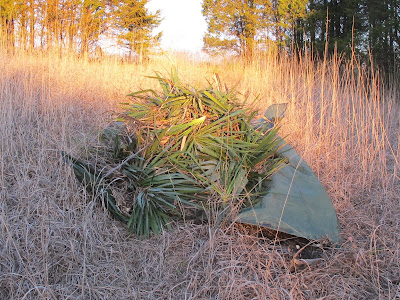Yucca, Yucca
filamentosa, has slowly been encroaching on one of my prairie areas. Yucca
filamentosa is a North American native plant originally confined to the south-eastern
portion of the United States. It is
considered to be a naturalized species in Ohio, with populations generally
spreading from sites of human habitation where Yucca was planted for such uses
as food, medicine or ornamental purposes.
Since I manage for native populations, the Yucca, non-native in my area,
has always been on my list of plants to eradicate, but there have always been
more serious matters for me to deal with.
A few years ago I began to notice new Yucca populations popping up
hundreds of feet from the original infestation.
That discovery caused me to move Yucca removal to a higher level on my
priority list. After a couple of years
testing treatment methods, I began in March 2020 to eliminate Yucca from Blue
Jay Barrens on a large scale.
The vertical stem is generally quite short, but can
sometimes reach up to a foot in height.
The leaves grow in a whorl from the stem with new growth coming from the
tip. The old leaves die to form a thick
mulch that eliminates any competing plants from growing near the Yucca.
Here is the point of original infestation. This open hilltop allowed for seeds to easily
spread down hill.
I thought the origin site to be an excellent beginning point
for Yucca eradication. Especially since
I have a well used walking trail running along the edge of this area and I was
tired of seeing Yucca every time I went by.
From the top of the hill, Yucca spread down the slope to the
west.
With this area cleared, I really had to stretch my neck to
see any Yucca from the trail.
Yucca spread out near the base of the hill. All cut Yucca plants were moved to a brush
pile seen just to the right of the center of this photo.
At this point, all Yucca plants in the prairie area have
been removed. Those plants showing on
the right side of the photo were removed the day after this picture was taken.
Deer will generally not browse Yucca plants. However, they seem to very much like the
stems and treat the brush pile as a huge feeding station. Individual plants are pulled out of the pile
by the deer. They dine on the normally unreachable stem and leave the tops
strewn about, sometimes a long distance from the pile. Cut Yucca plants will easily root and
continue growing if left on the ground, so I have to periodically gather up the
tops and replace them on the brush pile.
I’ve removed Yucca from about one and a half acres of open
prairie. I still have about a half acre
of Yucca growing in a shaded drainage area.
Other priorities have temporarily taken me away from this work, but I
hope to continue the Yucca removal job later in the summer. At a minimum, I will cut the flower stalks to
eliminate seed production for this year.
A clump of mature Yucca plants appears to be a formidable
adversary, but pushing aside the lower leaves reveals a soft underbelly. Although the stems may reach a diameter of
two inches, they are very soft. I had no
trouble slicing the stem with a pair of standard hand pruners, often severing
the stem by simply pushing the pruner blade on through.
Removing the cut plant reveals the severed stems surrounded
by a dead zone resulting from shading by the Yucca leaves. In some of the larger clumps, lateral stems
were poised to add to the size of the colony.
All parts of the stem in contact with the ground produce roots, so each
new stem could become a standalone plant.
The roots are reddish in color and can be seen near the cut stems.
After cutting, I applied concentrated glyphosate, typically
a 41% solution, to each cut stem. Not
knowing if the glyphosate would effectively eliminate the developing stems, I
cut the tip from each young stem and treated it with glyphosate. In my earlier trials, this method proved to
be nearly 100% effective in killing the entire plant.
I treated a wide range of plant sizes. Large plants were the easiest to find, cut
and treat. Smaller sized plants, such as
that shown just below the large cut stem in the photo, were harder to locate.
Over the next few years I’m sure to be dealing with many
small plants that evaded my search, but I’m sure the days of a widespread Yucca
invasion are over.




















Nice to hear from you! The idea that Yucca could be invasive like that is totally new to me up here in Ontario.
ReplyDeleteHi, Stew. Yucca exhibiting invasive behavior doesn't seem to be a common occurrence, but I have seen it happen several times in southern Ohio. If the conditions are suitable, I believe any plant is capable of taking advantage of the situation and expanding its population.
DeleteThanks for sharing. Have a great day.
ReplyDeleteYou're welcome, Greg.
Delete